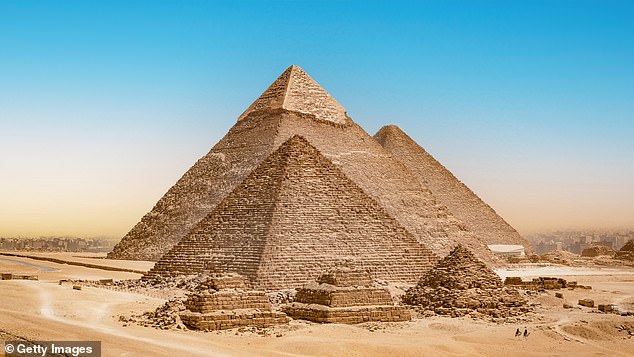A growing body of controversial evidence is challenging the long-accepted timeline of the Great Pyramid, and raising new questions about who may have built it.
British author Graham Hancock recently appeared on the American Alchemy podcast, where he claimed geological and astronomical clues suggest the monument was not built 4,500 years ago by Pharaoh Khufu, but by a lost civilization 12,500 years ago.
‘There’s no doubt that parts of the Great Pyramid were completed and finished by the ancient Egyptians,’ Hancock told podcast host Jesse Michels.
‘I don’t seek to take it away from them, but I think they were inheriting a very ancient tradition and completing a monument that already stood in basic form on the Giza Plateau.’
One of Hancock’s central arguments centers on the erosion patterns of the nearby Great Sphinx, saying that only heavy rainfall over thousands of years could have caused such deep weathering.
‘No such rains were on the Giza Plateau 4,500 years ago, but they certainly were at the end of the last Ice Age,’ he said.
However, renowned Egyptologist Dr Zahi Hawass has disputed these claims.
He told the Daily Mail he had discovered workers’ tombs dating to the 13th century BC and dismissed the erosion theory, attributing the Sphinx’s damage to millennia of wind, not rain.

The Giza Plateau, featuring three pyramids, is a mystery due to their unclear construction methods, precise astronomical alignment and still-debated purpose
‘If someone built this pyramid 12,000 years ago, aren’t you going to leave any evidence at the site to prove that?’ said Dr Hawass.
‘Me and my colleague, Mark Lehner, have excavated Giza for the last 50 years. All that we discovered until now has to do with the Fourth Dynasty.’
The Great Pyramid of Giza is the largest Egyptian pyramid, and was constructed by Pharaoh Khufu, who ruled during the Fourth Dynasty of the Old Kingdom.
It is one of three within the Giza plateau, the other two include the Pyramid of Khafre and the Pyramid of Menkaure, as well as the Great Sphinx.
All shrouded in mystery due to their unclear construction methods, precise astronomical alignment and still-debated purpose.
Dr Hawass shared further insights during a July appearance on the Matt Beall Limitless podcast, including details about a planned excavation inside the Great Pyramid to search for Khufu’s lost tomb.
Hancock, however, remains unconvinced that any burial ever took place inside.
‘It’s well known that no burial of any Pharaoh was ever found in the Great Pyramid or, for that matter, in any of the 100 pyramids in Egypt,’ said Hancock, who is known for his controversial theories about ancient civilizations.

British author Graham Hancock claimed on the American Alchemy podcast that geological and astronomical clues point to the Great Pyramid being built not by Pharaoh Khufu 4,500 years ago, but by a lost civilization 12,500 years ago
‘It’s well known that no burial of any Pharaoh was ever found in the Great Pyramid or, for that matter, in any of the 100 pyramids in Egypt,’ said Hna
‘Some of that can be attributed to tomb robbery, but in the case of the Great Pyramid, it was completely closed and sealed until Arab raiders under Khalif Ma’mun broke in.
Read More
EXCLUSIVE Chilling new theory about mystery city beneath Egypt’s pyramids

‘They were expecting to find enormous treasures and wealth, but instead, they found a completely empty building with nothing inside.’
Hancock also rejected the mainstream view that the Great Pyramid was built in just 23 years during Khufu’s reign, calling that idea ‘absurd.’
Instead, he proposed that the structure may have taken hundreds, even thousands, of years to complete.
Adding to his theory, Hancock pointed to the massive bedrock foundations beneath the three pyramids at Giza, naturally existing formations that were leveled before construction.
While most archaeologists believe the foundations are natural, Hancock believes the platforms themselves are much older.

Renowned Egyptologist Dr Zahi Hawass has disputed these claims, saying he has excavated the region for at least 50 years and found no evidence that an unknown advanced civilization built the pyramids

One of Hancock’s central arguments centers on the erosion patterns of the nearby Great Sphinx , saying that only heavy rainfall over thousands of years could have caused such deep weathering
He linked the structures to a lost epoch known in Egyptian lore as Zep Tepi, or ‘The First Time,’ citing astronomical alignments between the pyramid platforms and Orion’s Belt as it appeared 12,500 years ago.
‘At 4,500 years ago, the stars of Orion’s Belt didn’t match up,’ he said.
‘The Great Sphinx was looking at the sun rising against the background of Taurus. But in 12,500 BC, it aligned perfectly with Leo.’
Dr Hawass, however, dismissed Hancock’s claims as unfounded, emphasizing that the ancient Egyptians left behind detailed records of the Great Pyramid’s construction.
‘The Wadi El-Jarf Papyri is a diary from an overseer named Merer,’ he said. ‘He wrote, ‘I am from the Delta. I was hired by Khufu and held the title of inspector, with 40 workmen under me.’
The papyri also describe how Merer led crews to the Tura quarries to cut fine white limestone, which was then transported on wooden sledges to cargo boats. These vessels docked at harbors built in front of each pyramid.
‘Egyptian history has no gaps that would justify dating the pyramids to 12,000 or 20,000 years ago,’ Hawass added.
‘That era, known as the Epipaleolithic period, marked the earliest stages of civilization, far too primitive for monuments of this scale.’
